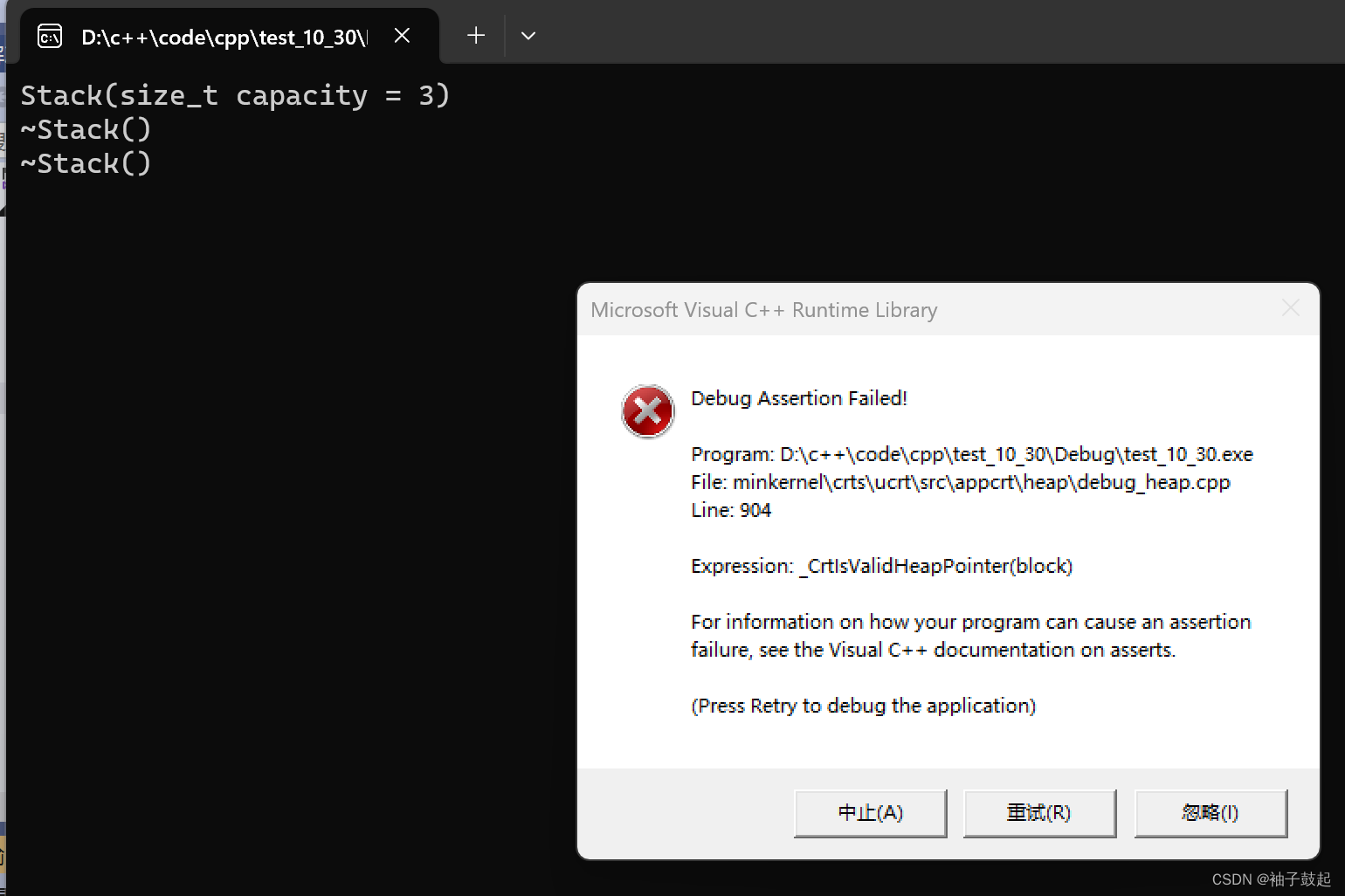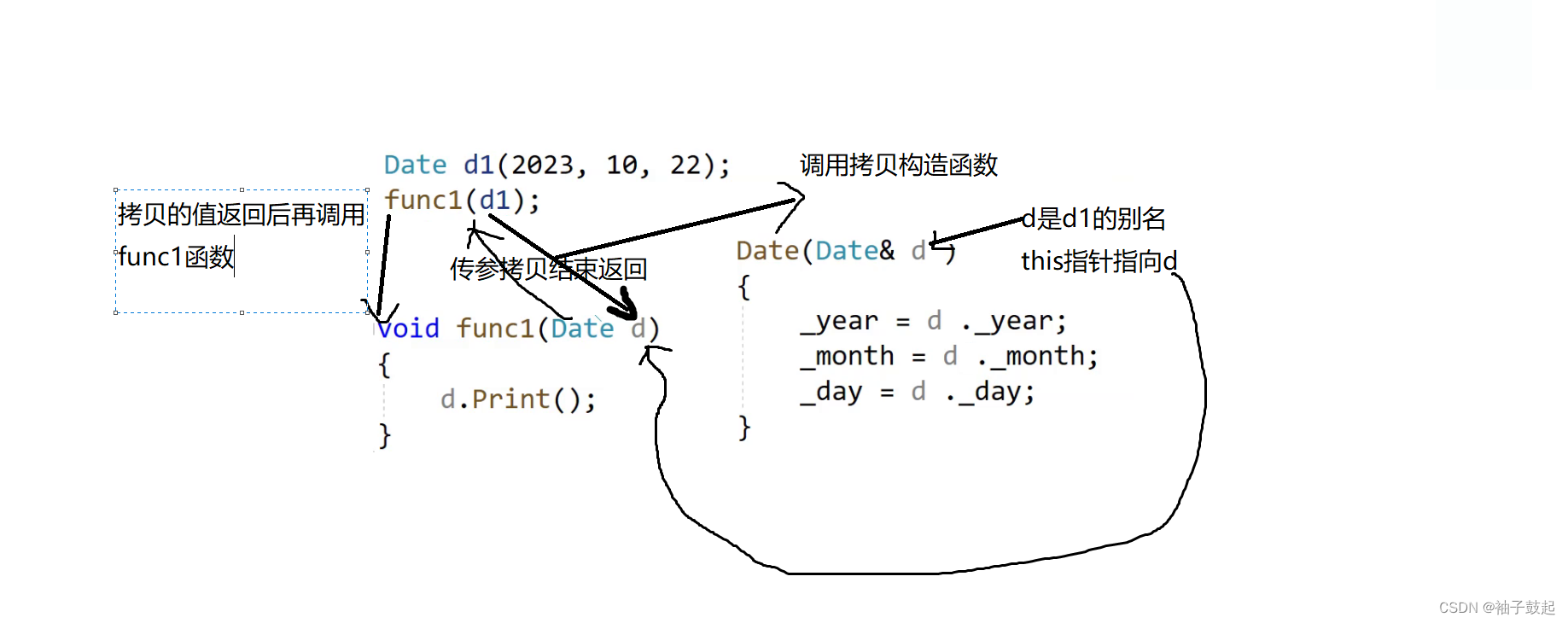目录
拷贝构造函数
一、为什么用拷贝构造
日期类传值(这里是浅拷贝)
#include<iostream>
using namespace std;
class Date {
public:
Date(int year=1, int month=1, int day=1) {
_year = year;
_month = month;
_day = day;
}
void Print() {
cout << _year << "/" << _month << "/" << _day << endl;
}
private:
int _year ;
int _month ;
int _day ;
};
int main() {
Date d1;
d1.Print();
return 0;
}
运行后:

这里进行了传值的拷贝,形参传给实参,进行了值拷贝,也就是浅拷贝,所以并没有出现问题。
但是栈类的结构浅拷贝会出现问题
#include<iostream>
using namespace std;
class Stack
{
public:
Stack(size_t capacity = 3)
{
cout << "Stack(size_t capacity = 3)" << endl;
_a = (int*)malloc(sizeof(int) * capacity);
if (nullptr == _a)
{
perror("malloc申请空间失败!!!");
}
_capacity = capacity;
_top = 0;
}
~Stack()
{
cout << "~Stack()" << endl;
free(_a);
_capacity = _top = 0;
_a = nullptr;
}
private:
int* _a;
int _capacity;
int _top;
};
int main() {
Stack st1;
Stack st2(st1);
return 0;
}
运行后会变成

从上面我们可以看出程序崩溃了,这是为什么呢?
原因在于我们的栈的结构体类型中有一个指针来指向下一个结构体,当我们进行浅拷贝的时候会将这个地址也拷贝过去,但是我们的c++会自动调用析构函数,那么析构函数就被调用了两次,从上面的图中我们也可以看出来析构函数被调用了两次,所以程序崩溃了。
那么如何解决这个问题呢,我们的C++祖师爷,就定义了一个拷贝构造函数 来解决这个问题。
二、拷贝构造函数
1、概念
拷贝构造函数:只有单个形参,该形参是对本类类型对象的引用(一般常用const修饰),在用已存在的类类型对象创建新对象时由编译器自动调用。
2、特征
拷贝构造函数也是特殊的成员函数,其特征如下:
1. 拷贝构造函数是构造函数的一个重载形式。
2. 拷贝构造函数的参数
拷贝构造函数的参数只有一个且必须是类类型对象的引用,使用传值方式编译器直接报错,因为会引发无穷递归调用。
下面写一个拷贝构造函数重新进行运行:
#include<iostream>
using namespace std;
class Stack
{
public:
Stack(size_t capacity = 3)
{
cout << "Stack(size_t capacity = 3)" << endl;
_a = (int*)malloc(sizeof(int) * capacity);//要重新开辟空间
if (nullptr == _a)
{
perror("malloc申请空间失败!!!");
}
_capacity = capacity;
_top = 0;
}
//拷贝构造函数
Stack(const Stack& stt ) {
_a = (int*)malloc(sizeof(int) * stt._capacity);
if (_a == nullptr) {
perror("malloc");
exit(-1);
}
memcpy(_a, stt._a, sizeof(int) * stt._top);
_capacity = stt._capacity;
_top = stt._top;
}
~Stack()
{
cout << "~Stack()" << endl;
free(_a);
_capacity = _top = 0;
_a = nullptr;
}
private:
int* _a;
int _capacity;
int _top;
};
void Func(Stack stt) {
//....
}
int main() {
Stack st1;
Func(st1);
return 0;
}
就会发现是正常运行,如下
//拷贝构造函数
Stack(const Stack& stt ) {
_a = (int*)malloc(sizeof(int) * stt._capacity);
if (_a == nullptr) {
perror("malloc");
exit(-1);
}
memcpy(_a, stt._a, sizeof(int) * stt._top);
_capacity = stt._capacity;
_top = stt._top;
}
通过拷贝构造函数我们可以看出,是重新开辟了一块空间进行拷贝构造,而且我们使用了引用(&)。那么为什么要用引用呢?
下面我们用日期类函数进行演示:
#include<iostream>
using namespace std;
class Date {
public:
Date(int year=1, int month=1, int day=1) {
_year = year;
_month = month;
_day = day;
}
//错误的拷贝构造函数
Date(Date d) {
_year = d._year;
_month = d._month;
_day = d._day;
}
void Print() {
cout << _year << "/" << _month << "/" << _day << endl;
}
private:
int _year ;
int _month ;
int _day ;
};
int main() {
Date d1;
d1.Print();
Date d2(d1);
d2.Print();
return 0;
}
我们会发现代码没有办法运行,进行下面的报错

这是由于当我们d2要对d1进行拷贝构造时发生了以下过程:
规定传值传参都要去调用拷贝构造函数那么,中间就还有临时变量要创建和拷贝,这样一环套一环没有终点。如下:

综上,所以我们要用引用,直接将d1赋值给d,如下所示:

#include<iostream>
using namespace std;
class Date {
public:
Date(int year=1, int month=1, int day=1) {
_year = year;
_month = month;
_day = day;
}
//正确的拷贝构造函数
Date(Date& d) {
_year = d._year;
_month = d._month;
_day = d._day;
}
void Print() {
cout << _year << "/" << _month << "/" << _day << endl;
}
private:
int _year ;
int _month ;
int _day ;
};
int main() {
Date d1;
d1.Print();
Date d2(d1);
d2.Print();
return 0;
}
3. 若未显式定义,编译器会生成默认的拷贝构造函数。
默认的拷贝构造函数对象按内存存储按字节序完成拷贝,这种拷贝叫做浅拷贝,或者值拷贝。
注意:类中如果没有涉及资源申请时,拷贝构造函数是否写都可以;一旦涉及到资源申请时,则拷贝构造函数是一定要写的,否则就是浅拷贝。
所以其实日期类是不用进行我们自己写拷贝构造函数的,因为日期类浅拷贝就够用了,我在上面用日期类进行举例是为了方便我们理解。拷贝构造还是主要用在我开始写的栈类型的程序上。
#include<iostream>
using namespace std;
class Stack
{
public:
Stack(size_t capacity = 3)
{
cout << "Stack(size_t capacity = 3)" << endl;
_a = (int*)malloc(sizeof(int) * capacity);//要重新开辟空间
if (nullptr == _a)
{
perror("malloc申请空间失败!!!");
}
_capacity = capacity;
_top = 0;
}
//拷贝构造函数
Stack(const Stack& stt ) {
_a = (int*)malloc(sizeof(int) * stt._capacity);
if (_a == nullptr) {
perror("malloc");
exit(-1);
}
memcpy(_a, stt._a, sizeof(int) * stt._top);
_capacity = stt._capacity;
_top = stt._top;
}
~Stack()
{
cout << "~Stack()" << endl;
free(_a);
_capacity = _top = 0;
_a = nullptr;
}
private:
int* _a;
int _capacity;
int _top;
};
void Func(Stack stt) {
//....
}
int main() {
Stack st1;
Func(st1);
Stack st2(st1);
return 0;
}
通过调试上述代码我们发现,它们_a的地址不同,但是_capacity、_top的值是相同的,成功完成了拷贝构造。

运行后的结果如下:

4. 拷贝构造函数典型调用场景
使用已存在对象创建新对象
函数参数类型为类类型对象
函数返回值类型为类类型对象





















 808
808











 被折叠的 条评论
为什么被折叠?
被折叠的 条评论
为什么被折叠?








